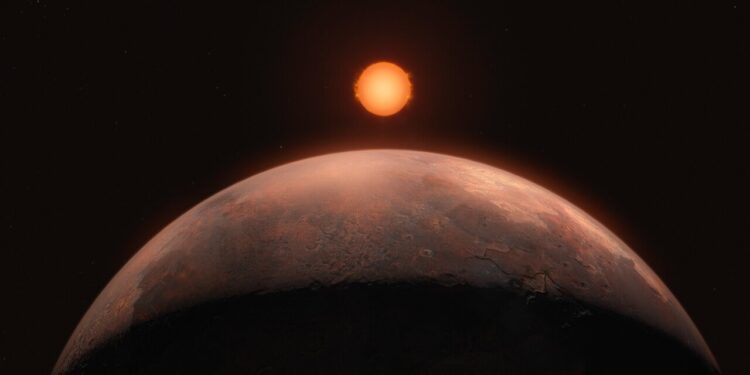This artist’s impression shows Barnard b, a lower-mass planet than Earth that was discovered orbiting Barnard’s star. Its signal was detected with the ESPRESSO instrument on ESO’s Very Large Telescope (VLT), and astronomers were able to confirm it with data from other instruments. An earlier promising detection in 2018 around the same star could not be confirmed by this data. On this recently discovered exoplanet, which has at least half the mass of Venus but is too hot to support liquid water, a year lasts just over three Earth days. Credit: ESO/M. Harbinger of Korn
Using the European Southern Observatory’s Very Large Telescope (ESO’s VLT), astronomers have discovered an exoplanet orbiting Barnard’s Star, the closest star to our sun. On this recently discovered exoplanet, which has at least half the mass of Venus, a year lasts just over three Earth days. The team’s observations also suggest the existence of three other candidate exoplanets, in various orbits around the star.
Located just six light years away, Barnard’s Star is the second closest star system, after the Alpha Centauri cluster of three stars, and the closest individual star to us. Due to its proximity, it constitutes a privileged target in the search for exoplanets similar to Earth. Despite a promising detection in 2018, no planet orbiting Barnard’s star had been confirmed until now.
The discovery of this new exoplanet, announced in an article published today in the journal Astronomy and astrophysics— is the result of observations made over the past five years with the ESO VLT, located at the Paranal Observatory in Chile. “Even though it took time, we were still sure we could find something,” says Jonay González Hernández, a researcher at the Instituto de Astrofísica de Canarias in Spain and lead author of the paper.
The team was looking for signals from possible exoplanets located in the habitable or temperate zone of Barnard’s star, the area where liquid water can exist on the planet’s surface. Red dwarfs like Barnard’s Star are often targeted by astronomers because low-mass, rocky planets are easier to detect there than around larger stars like the Sun.
Barnard b, as the newly discovered exoplanet is called, is twenty times closer to Barnard’s star than Mercury is to the sun. It orbits its star in 3.15 Earth days and has a surface temperature of approximately 125°C.
“Barnard b is one of the lowest known mass exoplanets and one of the few known with a mass less than that of Earth. But the planet is too close to the host star, closer than the habitable zone “, explains González Hernández. “Even though the star is about 2,500 degrees cooler than our sun, it is too hot to maintain liquid water on the surface.”
For their observations, the team used ESPRESSO, a highly precise instrument designed to measure the wobble of a star caused by the gravitational pull of one or more orbiting planets. The results obtained from these observations were confirmed by data from other instruments also specialized in exoplanet hunting: HARPS from ESO’s La Silla Observatory, HARPS-N and CARMENES. The new data, however, does not support the existence of the exoplanet reported in 2018.
In addition to the confirmed planet, the international team also found evidence of three other exoplanet candidates orbiting the same star. These candidates will, however, require additional observations with ESPRESSO to be confirmed.
“We now need to continue observing this star to confirm the other candidate signals,” explains Alejandro Suárez Mascareño, a researcher also at the Instituto de Astrofísica de Canarias and co-author of the study. “But the discovery of this planet, along with other previous discoveries such as Proxima b and d, show that our cosmic backyard is full of low-mass planets.”
ESO’s Extremely Large Telescope (ELT), currently under construction, is poised to transform the field of exoplanet research. The ELT’s ANDES instrument will allow researchers to detect more of these small, rocky planets in the temperate zone around nearby stars, beyond the reach of current telescopes, and study the composition of their atmospheres.
More information:
A planet with a mass less than Earth orbiting Barnard’s starAstronomy and Astrophysics (2024). DOI: 10.1051/0004-6361/202451311. www.aanda.org/10.1051/0004-6361/202451311
Quote: Scientists discover a planet orbiting the star closest to our sun (October 1, 2024) retrieved October 1, 2024 from
This document is subject to copyright. Except for fair use for private study or research purposes, no part may be reproduced without written permission. The content is provided for informational purposes only.



